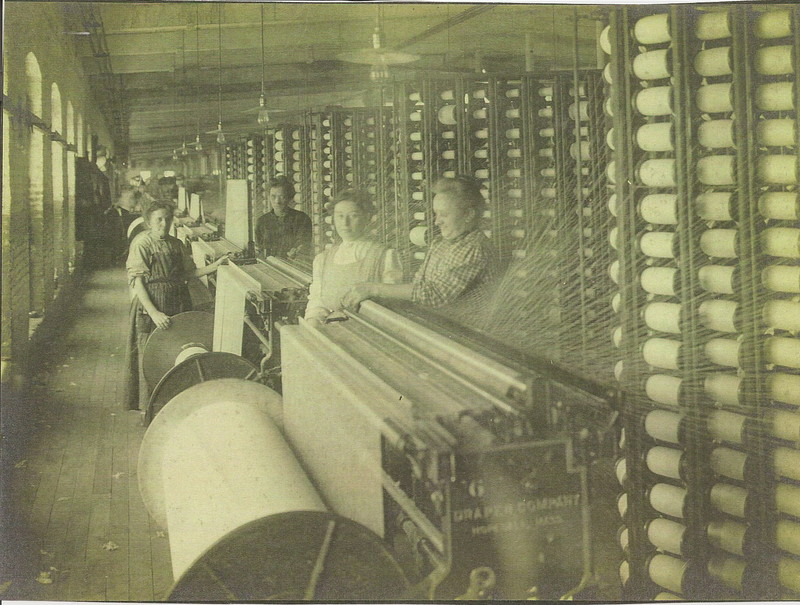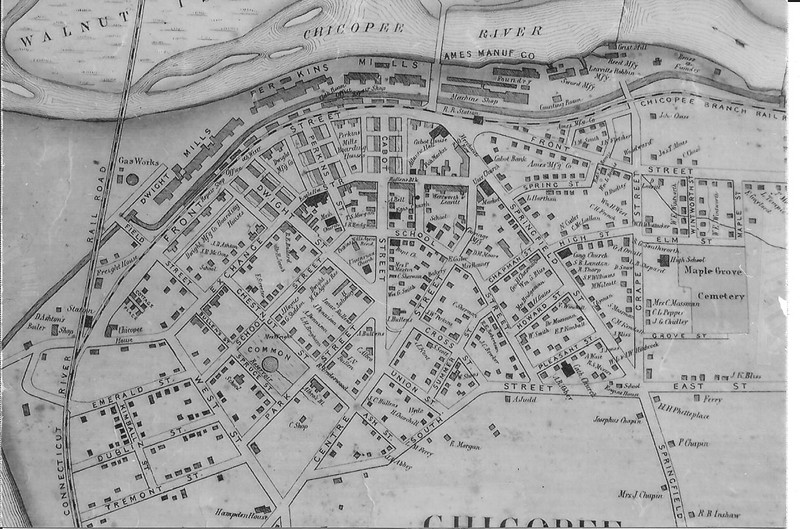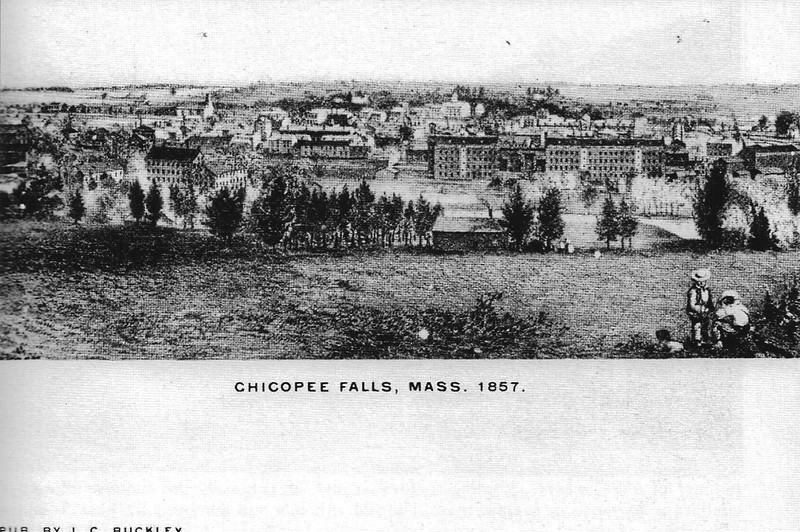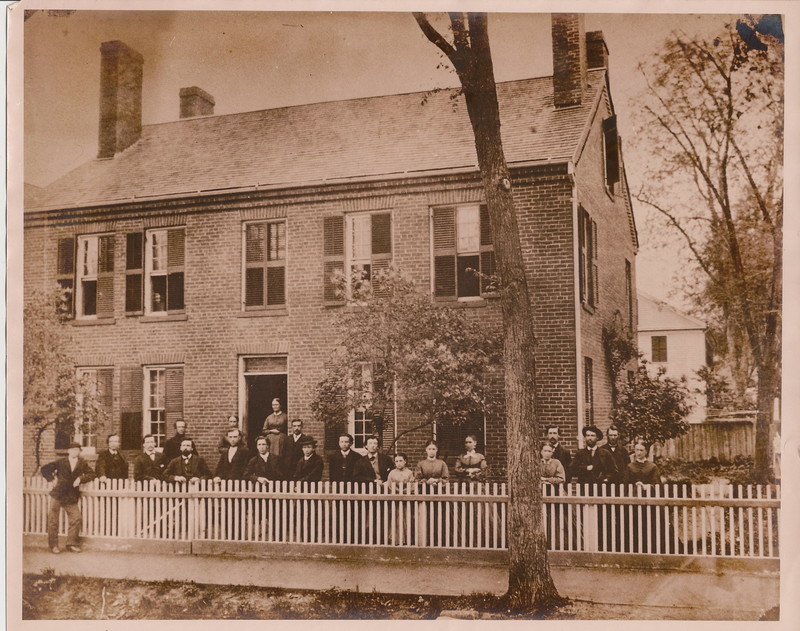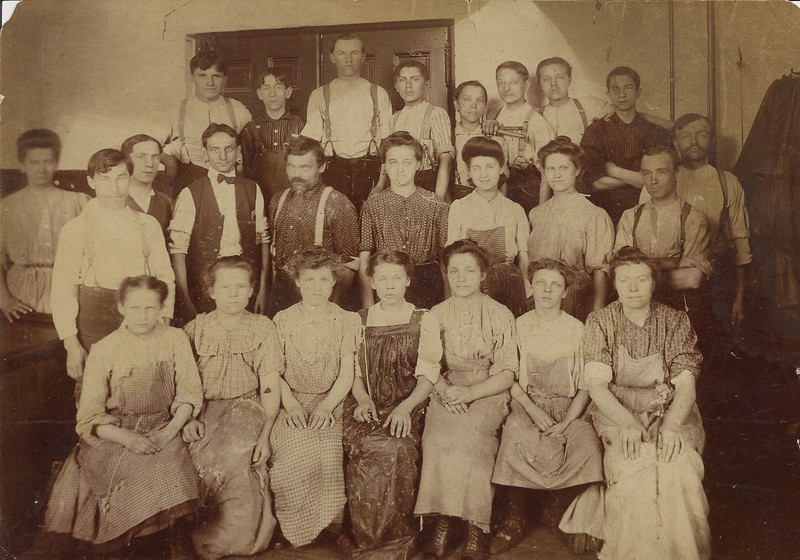Chicopee Factory Girls
Local history books give credit for the industrial success of Chicopee to the men who established and invested in the various manufacturing companies in the city. Boston financiers were key to the development of Chicopee from an agricultural village into an industrial city with worldwide recognition as a manufacturing Mecca. Yet, the importance of the workers who made up the backbone of the industry’s workforce, especially the role of the female cotton factory workers is often overlooked. This section is meant to draw attention to The Factory Girls of Chicopee, Massachusetts in the early-mid 19th century.
Dwight Mills
Early-mid 19th century photographs of Chicopee mill workers are virtually non-existent. Working in the Dwight Mill, these women used the most advanced machinery available at the time, automatic Draper Looms.
Photograph courtesy of Chicopee Historical Society
Cabotville, Chicopee
Development of additional cotton mills in the area known as Cabotville followed the model of the Chicopee Manufacturing Company and by 1841, the Cabot Manufacturing Company, the Dwight Manufacturing Company, and the Perkins Mills were built. Following the model of the Chicopee Manufacturing Company, these cotton mills also erected schools, churches, and stores that sold produce, clothing, firewood, and other necessities to the workers.
Chicopee Falls
The potential for water power created by the unique location of the Chicopee River and the Chicopee Falls attracted wealthy investors from Boston to the agricultural village community of Chicopee. The first cotton mill in Chicopee, Chicopee Manufacturing Company was located in the village of Chicopee Falls. Chicopee Manufacturing Company and several boarding house are visable in this scene.
Photograph courtesy of Chicopee Historical Society
Company Housing
Construction of boarding houses at Chicopee Falls for Chicopee Manufacturing Company in the 1830's created housing for over 500 girls (and 200 men) from neighboring towns.
Boarding houses were run by matrons who strictly enforced the rules of the house including a 10pm curfew, temperance, and weekly church attendance. Mill girls were charged approximately $1.25 per week to live in overcrowded boarding houses with as many as six girls per room, which permitted virtually no privacy. Female operatives worked twelve hours a day and earned $3-$5.40 dollars per week. Many of these young women sent their wages home to their families, but some simply saved their earnings for their future nuptuals and household neccessities. For recreation, the factory girls attended reading and writing classes offered specifically for them, joined reading circles, knit, and went shopping.
Photograph courtesy of Chicopee Historical Society
Cotton Mill Workers
The cotton mills initially hired female workers (operatives) from local communities such as Belchertown, Granby, and West Springfield as there was not enough local labor to run the mill but eventually recruiters were sent further north and west to find enough labor. They recruited girls from their family farms in the states of New York, Vermont, and New Hampshire to work in the Chicopee mills. It is these first female factory workers and their lives as workers that
are the subject of this display.
The Chicopee factory girls worked 12 ½ hours a day and were paid between $3-$5.40 dollars per week, and were charged approximately $1.25 per week to live in overcrowded boarding houses in rooms with as many as six other girls. These boarding houses were owned by the cotton mills and run by matrons who would strictly reinforce the rules of the house including a 10pm curfew, temperance, and weekly church attendance.
The Olive Leaf (May-October 1843)
Published between May and October of 1843 at the cost of one dollar a year.
The prospectus states, The Olive Leaf is a semi-monthly paper, devoted to the interests of the Operatives at Cabotville and Chicopee Falls, and throughout the New England States . . . The matter will be chiefly original, containing articles, Religious, Literary, and Historical. The paper will be free from a party spirit, and nothing will be admitted to its columns with a view to establish any particular opinion. Virtue and Morality will be its leading characteristics, while the chief aim of the Editor shall be to benefit that class, to whose welfare it is devoted, and at the same time endeavor to be interesting to all. The principal(sic) contributors will be the Operatives, whose communications will be ever gratefully received.
The Olive Leaf, September 16, 1843
One of the ways we know about the lives and interests of Chicopee factory girls is by reading local newspapers of the time. In 1843, female workers contributed to a semi-monthly newspaper called The Olive Leaf and Factory Girl’s Repository. The Olive Leaf was, “devoted to the interests of the Operatives at Cabotville and Chicopee Falls,” and contained articles written by and for mill operatives. Each edition of The Olive Leaf included articles on history, religion, poetry, and fiction which focused on death & dying, bereavement & loss, and love & romance.
On September 16, 1843, a factory worker named Mary Jane wrote a letter to the editor of The Olive Leaf describing her life working on her family’s farm in New Hampshire prior to working in the mills. In addition, she writes about learning to read while in Chicopee and her easy access to books. Mary Jane comments on the respectability of the mill girls by stating, “one and all [factory girls] dressed as neat, clean and looking more tidy than Queen Victoria in all her attire of royalty...”
